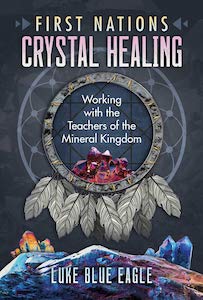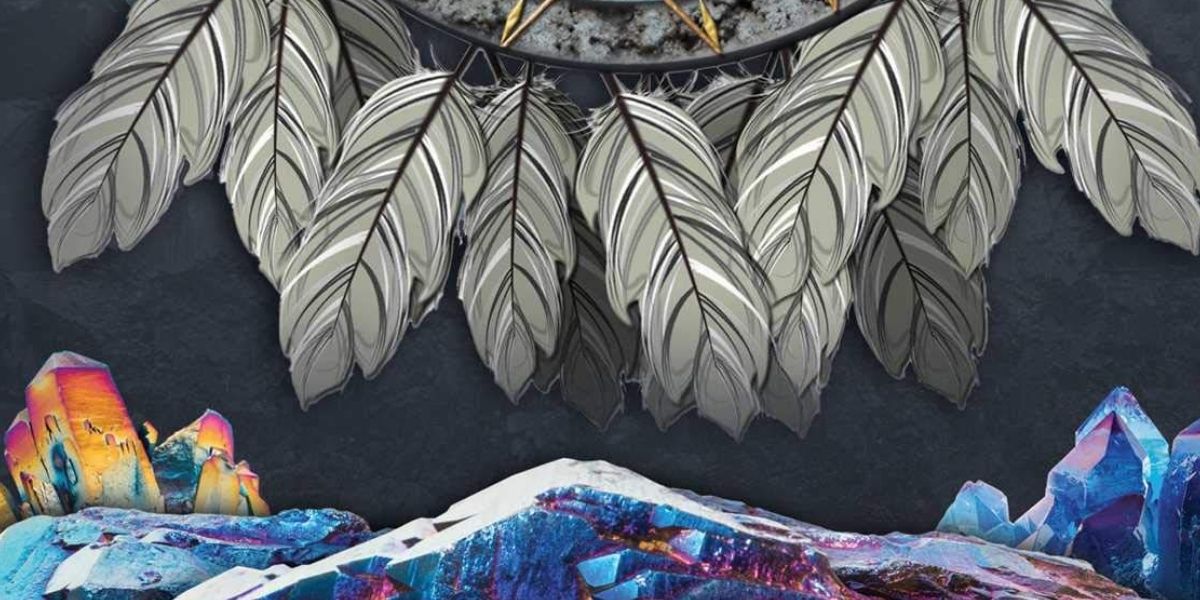
First Nations Crystal Healing: Working with the Teachers of the Mineral Kingdom, by Luke Blue Eagle
Bear & Company, 9781591434276, 264 pages, October 2021
Luke Blue Eagle shares ways to use thirty-eight different crystals and stones for healing in his book First Nations Crystal Healing. As he says on the back cover:
“Crystals and stones come from Mother Earth and indigenous medicine people have been using them to help and to heal for millennia. Their techniques, although simple, have proven effective through the innumerable healers who have handed down these teachings across the generations.”1
For over twenty-five years, Blue Eagle studied with elders from several indigenous tribes in the US and Canada. He writes a blog that includes articles on many subjects, from animal totems such as the moose or coyote to crystals or the latest work on his fragrances or his original music. He is also featured in several audio interviews online. His career spans over forty years as a healer and practitioner. A recent blog announces that he has retired from active work, having trained quite a few people to carry on these techniques.
This book is organized into five parts:
- Preparing for a Healing Practice
- Crystal Attributes and Correspondences
- Principal Practices for Crystal Use and Care
- Advanced Healing Practices
- The Stones and Their Properties
I have been interested in crystals and gemstones for more than twenty years, so this book really resonated with me. When my husband and I began to study mediumship, we learned about a few crystals that can support spirit communication. From that time, I’ve loved to use crystals for channeling, healing, and energy clearing. I was interested to learn more from Blue Eagle about indigenous techniques and practices.
In the initial section, I learned that the indigenous way of healing is truly “holistic” in that it works to treat the whole body system: physical, mental, emotional and spiritual. Crystals are a natural part of the healing journey, since they come from Mother Earth. Blue Eagle reviews the foundations of Native American practices and provides some preliminary information, including his own fundamental laws of healing.
Next, he discusses the attributes of crystals, including form and structure and the colors of crystals. In the third section, he reviews ways to care for and use crystals and this was my favorite section. From consecrating a crystal to programming a crystal, Blue Eagle gives the reader step-by-step instructions. He shares:
The consecration ceremony is a twenty-seven-day ritual that will help you commune with your crystal and perceive its specific gifts and then apply them to healing situations. We use this ceremony to consecrate the crystal to act in a specific way, and in specific circumstances, in a sacred manner. All healing has a sacred component to it, if you understand the notion of holistic healing. The best time to start a consecration ritual is on the new moon. If not possible on the new moon, any other time will do.2
After he covers how to “program” a crystal, he also discusses the importance of creating “sacred space” for all healing. I loved the “Heart Meditation” that he shared in the book, which is a three-part meditation and is the first practice he teaches in all of his classes.
In the center of the book are color photos of the thirty-eight crystals, including several of the clear quartz crystal, which is the primary crystal that he uses for healing work. In the next section, he covers all of the different colors of crystals and how each color plays a role in healing. He does a brief introduction of the color, or “color ray” as he calls it, and then lists specific crystals in that color and shares information about working with that crystal.
Throughout the book, Blue Eagle adds what he calls a “Teaching Story” that contains a specific reference to an experience he has had that relates to the crystal or practice or healing technique. One of my favorites was the one shared about Clear Quartz, in which he put a crystal around the neck of a beginning student. The woman was helping him in his booth at a wellness fair and was becoming overwhelmed by the energy of the many people coming through the booth. After he put on the crystal, she was able to work the rest of the day with ease and no dip in her energy.3
I was unaware of the ability of clear quartz to be used in this way. I decided to test it out and wore a necklace I have with a clear quartz crystal point one day when I was going to my granddaughter’s gymnastics meet. That day, I was able to stay longer than usual and did not feel my energy dip after I had been in the large gym for four hours. I can’t wait to test out more of his practices and techniques, including his distance healing techniques and many of the meditations.
On the last page of the book, Blue Eagle shares what he calls “the three fundamental laws of healing: unconditional love, nonattachment and intention. The philosophical foundations that countless elders have passed down through the generations have great validity. We must meditate on them so that we tread on solid ground, protecting ourselves and others with insight and wisdom.”4
Blue Eagle’s writing style is very conversational, and I appreciate the depth of his knowledge and experience. It shines through on every page. The structure of the book is well-conceived, and the “Table of Contents” is handy for reference. He also has an index, which is always helpful later, when you want to find and review a specific idea.
In this easy-to-read book, Blue Eagle provides lots of tools and techniques that just about anyone can follow. He recommends that you read First Nations Crystal Healing from front to back to fully understand the Native American way of living in harmony with Mother Earth. I would recommend this book to anyone who wants to learn more about crystals, as well know and understand Native American healing techniques and sacred ceremonies.

PJ Spur is an author, intuitive, spiritual mentor, astrologer, and hypnotist. She does tarot & oracle card readings, natal chart readings, grief coaching, and relationship healing. She also has hosted a weekly “Coffee & Cards” event with her Soul Compass Community for the past four years. Her book Navigating Grief with Grace is available on Amazon. Learn more at www.dearpj.com



